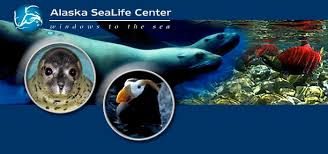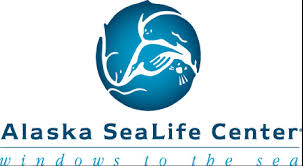Introducing the Cool and Cutting-Edge Alaska SeaLife Center!

Greetings! Well… according to NASA’s midyear climate analysis, 2016 is shaping up to be the hottest year on record! And they have been keeping records on our earth’s temperature since 1880. So to cool things off a bit for you, I’d thought I’d talk about the Alaska SeaLife Center, which is the only Alaskan facility where you’ll find a public aquarium, along with marine research and education.
The Alaska SeaLife Center is the only marine mammal rescue and rehabilitation facility in the state. The Center is located at “Mile 0” of the Seward Highway. It sits on the scenic shores of Resurrection Bay. The Alaska SeaLife Center is located about 127 miles south of Anchorage. Here is the Center’s address…
301 Railway Avenue
Seward, AK 99664
The Center explains, “Visitors to our ‘Windows to the Sea’ have close encounters with puffins, octopus, harbor seals, sea lions, and other marine life while learning about the work our researchers conduct both in the field and in our laboratories.”
History of the Alaska SeaLife Center
The Center’s concept actually revolved around the Exxon Valdez disaster, which occurred on March 24, 1989. The historic devastation began when the supertanker spilled 11 million gallons of oil into Alaska’s Prince William Sound. This resulted in severely damaging approximately 1,500 miles of Alaska’s beautiful coastline. The devastation caused extraordinary harm to wildlife. Thousands of marine life, including marine mammals, birds, and fish died within days and weeks after the major oil spill.
At time of the Exxon Valdez disaster, Alaska had no facility that could treat injured wildlife. So this initiated scientists to establish a facility, which could rehabilitate, research and monitor damaged wildlife on a long-term basis. And in February 1990 the Seward Association for the Advancement of Marine Science (SAAMS) formed. It was a 501 c 3 non-profit corporation used for “educational, social, and cultural purposes including marine research, public education, and providing education and scientific programs.” It was the goal of SAAMS to create “a world-class marine research, wildlife rehabilitation, and public education institution adjacent to the existing University of Alaska Seward Marine Center on Resurrection Bay in Seward, Alaska.” And it was that goal which advanced the completion of the Alaska SeaLife Center in 1998.
The Science Mission of the Alaska SeaLife Center
The Center explains, “The overall goal of our Science Program is to develop an understanding of the role of marine mammals, birds and fish in the arctic and subarctic marine ecosystems, and to generate scientific knowledge relevant to resource management and policy. Our projects focus on Alaska marine life and environments, but reach globally with international collaborations. The Center’s unique geographic location, marine cold water research facilities, live animal collections, and specialized staff allows us to use a combination of experimental and field research to:
- Investigate physiological and ecological processes affecting marine animal population dynamics.
- Conduct controlled experiments to understand factors affecting reproductive success and fitness in marine species.
- Monitor marine animal responses to environmental variability and stressors.
- Evaluate human impacts on our marine environment and animal populations.
- Develop tools to support recovery and restoration of marine resources.
Thus, an overarching science theme of our science relates to understanding of upper trophic level responses to environmental variability. Under this concept, we use marine mammals, seabirds, and fish as windows into the ecosystem they inhabit. As the arctic and subarctic are undergoing rapid environmental changes, understanding responses of these species to change is becoming urgently more important. A more holistic understanding of upper trophic species role in the arctic and subarctic marine ecosystems is essential, and our science team is developing research programs and partnerships towards integrated marine ecosystem studies to address these emerging broad scale topics.”
So if you live in Alaska or are visiting one of the most beautiful states in the United States, I suggest you make some plans to stop by the Alaska SeaLife Center!
If you see any sick or injured manatees, please call the Florida Fish and Wildlife Conservation Commission at: 1-888-404-FWCC. They are the folks who are responsible for rescuing us in Florida.
Here’s the Save the Manatee Club link to learn more about us manatees …
Here’s a cool link for you to learn more about how we’re rescued and brought into rehabilitation …
~ Kobee Manatee
